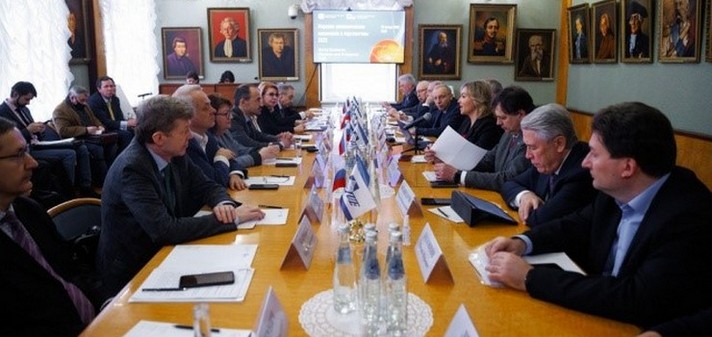Presentation of the Report “World economic situation and prospects 2023”
January 25, 2023
 Credits: veorus.ru
Credits: veorus.ru
On January 25, the „House of Economist“ hosted a presentation of the report „The World Economic Situation and Prospects for 2023“, organized by the UN Information Center in Moscow and the International Union of Economists (in General Consultative Status of the UN Economic and Social Council) with the participation of the Free Economic Society of Russia.
The World Economic Situation and Prospects 2023 presents a gloomy and uncertain economic outlook for the near term. Global growth is forecast to moderately pick up to 2.7 per cent in 2024 as some of the headwinds will begin to subside. However, this is highly dependent on the pace and sequence of further monetary tightening, the course and consequences of the war in Ukraine, and the possibility of further supply-chain disruptions.
The tepid global economic prospects also threaten the achievement of the 17 Sustainable Development Goals (SDGs), when the 2023 SDG Summit in September marks the mid-point of the implementation of the 2030 Agenda.
The presentation in Moscow was moderated by Alexander Dynkin, Vice President of the International Union of Economists, President of the E.M. Primakov RAS, Academician of the RAS. Representatives of the UNIDO CIIC took part in the presentation of the report and discussion.
The presentations of the report „The World Economic Situation and Prospects 2023“ were made by Vladimir Salnikov, Deputy General Director, Head of the Real Sector Analysis and Forecasting of the Center for Macroeconomic Analysis and Short-Term Forecasting (CMASF), and Irina Ipatova, Leading Expert of the CMASF.
According to the Report, US GDP may increase by only 0.4% in 2023, while the economic growth of the European Union will be about 0.2%. The gloomy forecasts regarding the contraction of the Russian economy in 2022 did not come true yet. At the beginning of 2022 experts estimated the fall in Russia’s GDP up to 10-15%, then by the end of the year it will be approximately 3.5%.
“Against the background of the imposed sanctions, Russia was able to reorient trade flows from West to East, significantly increasing exports to China, India and Turkey. Enterprises had stocks of materials and components in warehouses, so the second and third quarters of 2022 went smoothly. The Russian Central Bank took effective measures to maintain stability in the financial and foreign exchange markets. The interest rate was increased, which allowed, after the strengthening of the ruble, to move on to easing monetary policy. This stimulated corporate and retail lending,“ Irina Ipatova explained.
However, when stocks of foreign materials and components in the warehouses of domestic enterprises come to an end, economic growth in Russia may slow down. One of the risks for the global financial system, named in the Report, is the development of a debt crisis, which is primarily associated with an increase in the cost of servicing global debt. Nevertheless according to the Director of the Institute of Economics of the Russian Academy of Sciences Mikhail Golovnin, the global debt burden is not the main problem of the global financial system in 2023.
„The Economist magazine“ named 53 countries in which the situation in terms of debt burden is critical. However, the combined GDP of these countries is only 5% of global GDP,“ the scientist explained. Among other threats to the stability of the global financial system, Mikhail Golovnin named the outflow of capital from emerging markets and splitting up the global financial system, in particular, the reduction in demand for international reserve assets.
Scientific Director of the Institute for Economic Forecasting of the Russian Academy of Sciences, Academician of the Russian Academy of Sciences, member of the Presidium of the VEO of Russia Boris Porfiriev touched upon climate issues. According to the scientist, attention should be paid to climate change adaptation measures, while in the Report climate problems were narrowed to the reducing greenhouse gas emissions.
„In the report there are no corresponding estimates for adaptation to climate change. Meanwhile, the UN Environment Program (UNEP) Report (note — „Report on the difference in climate change adaptation measures for 2022“) was released, which showed that countries annually underinvest in the implementation of adaptation measures of about $ 170 billion, „said Boris Porfiriev.

